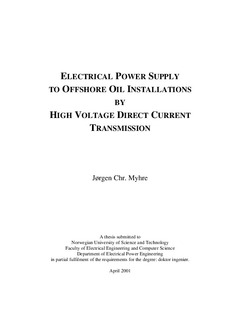| dc.contributor.author | Myhre, Jørgen Chr. | nb_NO |
| dc.date.accessioned | 2014-12-19T13:29:38Z | |
| dc.date.available | 2014-12-19T13:29:38Z | |
| dc.date.created | 2001-05-18 | nb_NO |
| dc.date.issued | 2001 | nb_NO |
| dc.identifier | 125094 | nb_NO |
| dc.identifier.isbn | 82-7984-186-5 | nb_NO |
| dc.identifier.uri | http://hdl.handle.net/11250/249774 | |
| dc.description.abstract | This study was initiated to investigate if it could be feasible to supply offshore oil installations in the North Sea with electrical power from land. A prestudy of alternative converter topologies indicated that the most promising solution would be to investigate a conventional system with reduced synchronous compensator rating.
The study starts with a summary of the state of power supply to offshore installations today, and a short review of classical HVDC transmission. It goes on to analyse how a passive network without sources influences the inverter. The transmission, with its current controlled rectifier and large inductance, is simulated as a current source. Under these circumstances the analysis shows that the network frequency has to adapt in order to keep the active and reactive power balance until the controllers are able to react. The concept of firing angle for a thyristor is limited in a system with variable frequency, the actual control parameter is the firing delay time.
Sensitivity analysis showed some astonishing consequences. The frequency rises both by an increase in the active and in the reactive load. The voltage falls by an increase in the active load, but rises by an increase in the inductive load.
Two different control principles for the system of inverter, synchronous compensator and load are defined. The first takes the reference for the firing delay time from the fundamental voltage at the point of common coupling. The second takes the reference for the firing delay time from the simulated EMF of the synchronous compensator. Of these, the second is the more stable and should be chosen as the basis for a possible control system.
Two simulation tools are applied. The first is a quasi-phasor model running on Matlab with Simulink. The other is a time domain model in KREAN. The time domain model is primarily used for the verification of the quasi-phasor model, and shows that quasi-phasors is still a valuable tool for making a quick analysis of the main features when the details of the transients are of less importance.
The study indicates that power supply by HVDC transmission from land to offshore oil installations could be technically feasible, even without the large synchronous compensators normally required. It has been shown that in a network only supplied by an inverter, variations of active and reactive loads have significant influence on both voltage and frequency. Particularly it should be noted that the frequency shows a positive sensitivity to increases in load. This could make the system intrinsically unstable in the case of a frequency dependent load such as motors.
It was not a part of the study to optimize controllers, but even with simple controllers it was possible to keep the frequency within limits given by norms and regulations, but the voltages were dynamically outside the limits, though not very far. These voltage overswings take place in the first few instances after a disturbance, so it takes unrealistically fast controllers to handle them. They are partly due to the model, where the land based rectifier and the DC reactors are simulated by a constant current source, but partly they have to be handled by overdimensioning of the system.
The simulations indicate that it should be technically possible to supply an oil platform with electrical power from land by means of HVDC transmission with small synchronous compensators. Whether this is financially feasible has not been investigated. Neither has it been considered whether the necessary equipment can actually be installed on an oil platform.
Recently both ABB and Siemens have presented solutions for HVDC transmission in the lower and medium power range based on voltage source converters based on IGBTs. Fully controllable voltage source HVDC converters have properties that may be better suited than conventional line commutated current source thyristor inverters, to supply weak or passive networks, such as offshore oil installations, with electrical power. But they also have some disadvantages, and a complete technical and financial comparison must be performed in order to decide about any potential project. | nb_NO |
| dc.language | eng | nb_NO |
| dc.publisher | Fakultet for informasjonsteknologi, matematikk og elektroteknikk | nb_NO |
| dc.relation.ispartofseries | Dr. ingeniøravhandling, 0809-103X; 2001:24 | nb_NO |
| dc.subject | | en_GB |
| dc.subject | Elektroteknik, elektronik och fotonik | en_GB |
| dc.subject | | en_GB |
| dc.subject | Elektroteknik | en_GB |
| dc.subject | | en_GB |
| dc.subject | Elkraftteknik | en_GB |
| dc.subject | TECHNOLOGY: Electrical engineering, electronics and photonics | en_GB |
| dc.subject | TECHNOLOGY: Electrical engineering, electronics and photonics: Electrical engineering | en_GB |
| dc.subject | TECHNOLOGY: Electrical engineering, electronics and photonics: Electric power engineering | en_GB |
| dc.title | Electrical Power Supply to Offshore Oil Installations by High Voltage Direct Current Transmission | nb_NO |
| dc.type | Doctoral thesis | nb_NO |
| dc.source.pagenumber | 248 | nb_NO |
| dc.contributor.department | Norges teknisk-naturvitenskapelige universitet, Fakultet for informasjonsteknologi, matematikk og elektroteknikk | nb_NO |
| dc.description.degree | dr.ing. | nb_NO |
| dc.description.degree | dr.ing. | en_GB |
